The document discusses TRM-RPL, a trust-based routing metric designed to enhance the RPL routing protocol used in the Internet of Things (IoT), particularly in smart factories. This model aims to detect and resist routing attacks while ensuring Quality of Service (QoS) and addresses both node and link trust through a multidimensional approach. Experimental results demonstrate that TRM-RPL outperforms the standard RPL in terms of effectiveness and resilience to various security threats.
![International Journal on AdHoc Networking Systems (IJANS) Vol. 10, No. 1/2/3, July 2020
DOI: 10.5121/ijans.2020.10301 1
TRUST BASED ROUTING METRIC
FOR RPL ROUTING PROTOCOL IN
THE INTERNET OF THINGS.
Asma Lahbib1
, Khalifa Toumi2
, Anis Laouiti1
and Steven Martin3
1
SAMOVAR, Télécom SudParis, CNRS, Université Paris-Saclay,
9 rue Charles Fourier 91011 Evry, France
2
IRT SystemX, 8 Avenue de la Vauve, 91127 Palaiseau, France
3
LRI, Université Paris-Sud, 15 Rue Georges Clemenceau, 91400 Orsay, France
ABSTRACT
While smart factories are becoming widely recognized as a fundamental concept of Industry 4.0, their
implementation has posed several challenges insofar that they generate and process vast amounts of
security critical and privacy sensitive data, in addition to the fact that they deploy IoT heterogeneous and
constrained devices communicating with each other and being accessed ubiquitously through lossy
networks. In this scenario, the routing of data is a specific area of concern especially with the inherent
constraints and limiting properties of such devices like processing resources, memory capacity and battery
life. To suit these constraints and to provide the required connectivity, the IETF has developed several
standards, among them the RPL routing protocol for Low powerand Lossy Networks (LLNs). However, and
even though RPL provides support for integrity and confidentiality of messages, its security may be
compromised by several threats and attacks. We propose in this work TRM-RPL, a Trust based Routing
Metric for the RPL protocol in an IIoT based environments. TRM-RPL uses a trust management
mechanism to detect malicious behaviors and resist routing attacks while providing QoS guarantees. In
addition, our model addresses both node and link trust and follows a multidimensional approach to enable
an accurate trust assessment for IoT entities. TRM-RPL is implemented, successfully tested and compared
with the standard RPL protocol where its effectiveniness and resilience to attacks has been proved to be
better.
KEYWORDS
Trust, RPL, QoS, Security, Energy efficiency, IoT, IIoT
1. INTRODUCTION
With the advancement in mobile computing and wireless communication, a new paradigm known
as IoT has emerged enabling a seamless integration of physical smart devices within the Internet
infrastructure, promoting as a consequence thereof a new generation of innovative and valuable
services provided by various application domains and industrial systems such as transportation,
healthcare and manufacturing systems. The integration of such paradigm within cyberphysical
system (CPS) utilizing Cloud Computing (CC) services in addition to big data and data analytics
techniques within industrial application scenarios, has introduced the fourth industrial revolution
sometimes referred to as Industry 4.0 [1–3]. In smart factories environments smart products know
their own identity, specification, history and even control their own production process, to do so a
set of specific data need to be collected in real time and sent to some backend storage structure.
The collection of such data is guaranteed by IoT devices with different sensing, connectivity,
storage, computational, and other capabilities. The resource.](https://image.slidesharecdn.com/10320ijans01-210930062715/75/Trustbased-Routing-Metric-for-RPL-Routing-Protocol-in-the-Internet-of-Things-1-2048.jpg)
![International Journal on AdHoc Networking Systems (IJANS) Vol. 10, No. 1/2/3, July 2020
2
constraints in sensor networks create novel challenges especially in communication and
networking in the presence of devices with limited power, computing and storage capabilities and
above all unreliable connectivity. For that reason, several standards and protocols were proposed
by the Internet Engineering Task Force (IETF), among them the IPv6 over LOW power wireless
Personal Area Networks (6lowPAN) adaptation layer introduced in order to enable IP addressing
and connectivity over low power and lossy networks [6]. Nevertheless, routing functionalities
were very challenging within 6lowPAN based networks due to the unique characteristics of IoT
entities which has arisen an increasing need for an efficient routing protocol for 6LoWPAN
compliant IoT networks. Hence the development of RPL, the Routing Protocol for Low power
and lossy networks [7], considered later as the standard routing protocol for IoT networks.
However and even tough RPL provide support for integrity and confidentiality of messages, its
security specifications do not address all possible attacks that may compromise the RPL network
which makes it necessary to develop suitable solutions to ensure its security against possible
attacks (such as the floodingattack, the routing table falsification attack, the black hole attack, the
eavesdropping attack, etc.). In this context, several solutions [8,21] have been proposed in an
attempt to bring some enhancements to the RPL standard specification. Nevertheless, little
attention has been paid to its security concept and justsome works [9,10,12–14] have investigated
and incorporated the trust management aspects within the RPL routing procedures. In this
direction, this work proposes a trust based routing metric for the RPL routing protocol with the
characteristics of lightweight and high ability to detect, isolate and resist against routing attacks
while providing QoS guarantees during the construction and the maintenance of the network
routing topology. Such model follows a multidimensional approach to enable an accurate trust
value computation for IoT entities. It uses security aspects, QoS factors, energy considerations in
addition to the reputation parameters considered by participating entities to assess the
trustworthiness of their neighboring ones. Thereafter, and based on the proposed trust aware
routing metric, a new RPL objective function is developed in order to rank participating entities
at the topology establishment and to calculate the most trusted path from each source entity to the
root. A set of evaluation results are then analyzed and discussed, to demonstrate the feasibility of
our proposal. TRM-RPL is a trust based routing metric for RPL, predicated on our earlier
proposed work presented in [14]. However in this last, validation was performed regarding two
set of attacks namely black hole and grey hole attacks, this study addresses another kind of
routing attack for which a set of experimental results will be provided. In addition, it enforces the
multidimensional aspect of our model and more specifically that relatedto its security dimension.
The rest of this paper is organized as follows. Section 2 overviews the RPL protocoland presents
related proposals regarding its security enhancements and trust aspects. Thereafter, Section 3
provides a brief description of the important properties to be considered as well as the main
objectives we attempt to accomplish. Afterwards, an overview of the proposed scheme, its
dimensions and the main blocksit relies on is given in Section 4. Section 5 delves into the
integration of the proposed scheme within the RPL protocol, a detailed scenario will be presented
then. In Section 6, a set of experimental results validating our approach are shown, and finally in
Section 7, the paper ends up with some conclusions and an outlook of our future work in this
area.](https://image.slidesharecdn.com/10320ijans01-210930062715/75/Trustbased-Routing-Metric-for-RPL-Routing-Protocol-in-the-Internet-of-Things-2-2048.jpg)
![International Journal on AdHoc Networking Systems (IJANS) Vol. 10, No. 1/2/3, July 2020
3
2. BACKGROUND AND LITERATURE REVIEW
2.1. Routing Protocol for Low Power and Lossy Networks
RPL, developed by the IETF working group, is an IPv6 routing protocol specifically designed for
LLNs with very limited resources in terms of energy, computation and bandwidth. This protocol
mainly targets collection based networks made up of nodes interconnected according to a specific
topology called Destination Oriented Directed Acyclic Graphs (DODAG), where sink nodes and
gateways act as the roots of the Directed Acyclic Graphs (DAGs). Within each DODAG, each
node is assigned a rank representing its position in the graph. Its computation depends on a set of
specific routing metrics (e.g. delay, link quality, throughput,etc.). The translation of these metrics
into ranks is based on an Objective Function (OF) responsible for rank computation and parent
selection. The DODAG construction and maintenance phases are based on a set of control
messages namely DODAG Information Object (DIO) delivered by the DODAG root to build
routes, DODAG Information Solicitation (DIS) broadcast by nodes willing to join the network,
Destination Advertisement Object (DAO) used to propagate reverse route information and
Destination Advertisement Object Acknowledgement (DAO-ACK) messages sent as an
acknowledgement of DAO messages.
2.2. Review of Existing Works
Several trust management schemes have been developed in the literature in the context of
wireless networks ([15], [16], [17]) to ensure secure routing by protecting the network against
misbehaving and selfish nodes thatgenerally aim to attack the routing protocol by dropping,
modifying and altering the transmitted routing packets, as well as disrupting the routing
processes. The integration of trust could solve efficiently the problems to be faced when securing
the routing scheme. However the proposed schemes are particularly dependent on the
environment they targeted and the routing protocol they are designed to be integrated within.
Additionally, some of them have been tailored to wireless sensor networks, without considering
the inherent requirements and features of IoT scenarios and more specifically those related to
smart factories environments. In fact they do not keep in view wireless interference, QoS and
energy constraints which make them little suitable to IoT devices used within smart factories.
When it comes to these networks, we may found several enhancements of the RPL protocol.
Some of them have just focused on its evaluation [19,20], others have tried to enhance its
performance [21,22], while just few ones have addressed its security and trust aspects [23, 24].
In [21], authors tried to overcome the limitations of the standardized RPL OFs providing thereof
QoS guarantees for LLNs while considering several routing metrics. However the security aspect
was not considered within the proposed approach keeping as a consequence thereof the routing
protocol under threat of attacks. This threat analysis was presented in [24] where authors have
detailed and classified the different attacks that could be initiated against the RPL protocol
according to the attacker’s goal as well as the network element to be impacted.
To secure the communication in an RPL based network, authors in [9] used the trusted Platform
Module to establish trustworthiness of nodes before exchanging keying material. However, the
trustworthiness assessment was only considered for keys’ exchange mechanism to verify the
identity of their suppliers and not for the routing path selection and establishment. In [10],
authors have proposed trusted-RPL in order to strengthen RPL by adding a new trust
worthinessmetric during the construction and the maintenance phases of its instances. The trust
assessment is based on the evaluation of the neighboring nodes’ behaviors during the topology](https://image.slidesharecdn.com/10320ijans01-210930062715/75/Trustbased-Routing-Metric-for-RPL-Routing-Protocol-in-the-Internet-of-Things-3-2048.jpg)
![International Journal on AdHoc Networking Systems (IJANS) Vol. 10, No. 1/2/3, July 2020
4
construction using selfishness, energy, and honesty components. However, they have not proven
the defense of the proposed scheme against attacks that could be launched.
For this reason, an amelioration was proposed in [11] which takes into account trust along the
path using collaborative trustworthiness evaluation between the different nodes.
In [12], authors have presented Sectrust, a lightweight SECure trust-based routing framework for
IoT nodes. The trust evaluation is based specifically on the successful interactions between
IoT nodes and its calculation is based on some metrics such as the prospect of the positive
interaction between the different nodes, their satisfaction and their energy level as well. However,
although the proposed framework was designed to isolate common routing attacks, its
effectiveness under these threats has not been proven nor evaluated.
In [13], a new RPL routing scheme based on lightweight trust computations was proposed as an
objective function to secure the RPL network. The evaluation of trust was based on the positive
and negative interac-tions regarding a specific target. Therefore, the topology is updated and
misbehaving nodes are removed from the routing graph.
In [14], authors have focused on the design and the integration of a novel Link reliable and trust
aware model into the RPL routing protocol. The proposed model targets both node and link trust
and follows a multidimensional approach to enable an accurate trust value computation for IoT
entities during the construction and the maintenance phases of RPL instances.
A summary of proposed secure schemes for RPL is presented in Table 1. As seen, current IoT
research has not yet fully and comprehensively investigated how to secure the routing processes
in RPL based networks especially those related to the routing topology construction and
maintenance phases, the communication establishment and progress and above all how to trust
the participating entities and how to secure the network against the different threats and attacks
this protocol is exposed to. In this context, several issues need to be seriously considered and
more investigated. On the one hand, the trust integration within the routing functions could affect
the performance of the routing protocol as longerpaths could be selected to avoid malicious nodes
and thus it could cause a more important delay and energy. On the other hand, more research is
required in terms of QoS consideration, and attacks resiliency. In fact proposed schemes are
generally designed to defend a specific class of attacks while trust could deal with various kind of
attacks while meeting both the energy and the QoS requirements. For this purpose, an inspiration
could be taken from other similar areas to IoT such as MANETs and WSNs where extensive
research has been carried out and several approaches have been proposed regarding trust
management for routing procedures. In an attempt to solve such issues, we have tried in our
previous proposal [14] to integrate a novel link reliable and trust aware model within the RPL
routing protocol. As an amelioration to that proposal, we tried in this version to enforce the
multidimensional aspect of our model and more specifically that related to its security dimension.
Obviously, more experiments were carried out to prove its efficiency.](https://image.slidesharecdn.com/10320ijans01-210930062715/75/Trustbased-Routing-Metric-for-RPL-Routing-Protocol-in-the-Internet-of-Things-4-2048.jpg)
![International Journal on AdHoc Networking Systems (IJANS) Vol. 10, No. 1/2/3, July 2020
5
Table 1. Comparison of trust based routing protocols
Work/Referen ce Performance
metrics
Addressed attacks Advantages Limitations
Towards a Not Cryptographic - Provides node - trust is done
trustcomputing considered attacks authentication. only for
architecture - Avoids suspicious exchanging
for RPL in routing information keys securely,
Cyber Physical not for routing.
Systems [9]
trusted Selfishness,en Not considered - Adds new - Does not
RPL[10] ergy and
honestyNot
considered
trustworthiness
metric during the
construction and the
maintenance of the
routing topology.
consider the
trust value along the
path.
- Simulation and real
implementation
is still missing.
Lightweight
SECure trust
based routing
framework for
IoT(SEC-trust)
[12]
Prospect of
positive
interactions,
satisfaction
level,checks
um value and
node energy
level
Blackhole and
Greyhole attacks
- Secure routing
decisions among
nodes are made,
unreliable routes
are isolated.
- Could be
adapted to other
environments like
e-commerce,
online shopping
and
social media
- Simulation and
real implementation
is still missing.
Trust-based
Resilient
Routing
Mechanism for
IoT[13]
Positive and
negative
interactions
Not considered - Represents trust
by opinion
triangles
- Considers just the
direct trust and not
the recommendati
ons
Link reliable Node Blackhole and - Targets both node - Considers just
and trust cooperativene Greyhole attacks and link trust one kind of
aware RPL for ss and - Follows a attacks (routing
IoT [14] competence. multidimensional attacks)
Link quality approach to enable
an
and accurate trust value
performance computation
a trust aware trust and QoS On-off attack, - To avoid false
recommendations
from misbehaving
nodes, an
inconsistency
check mechanism
is incorporated
- Do not keep
Secure
Routing
Framework in
WSNs(TSRF)
[15]
metrics (delay
and packet
loss rate)
conflicting
behavior,
selfish, bad
mouthing and
collusion attack
in view energy and
wireless in-terference
which leads to dead
nodes
and
compromised
network life-
time.](https://image.slidesharecdn.com/10320ijans01-210930062715/75/Trustbased-Routing-Metric-for-RPL-Routing-Protocol-in-the-Internet-of-Things-5-2048.jpg)
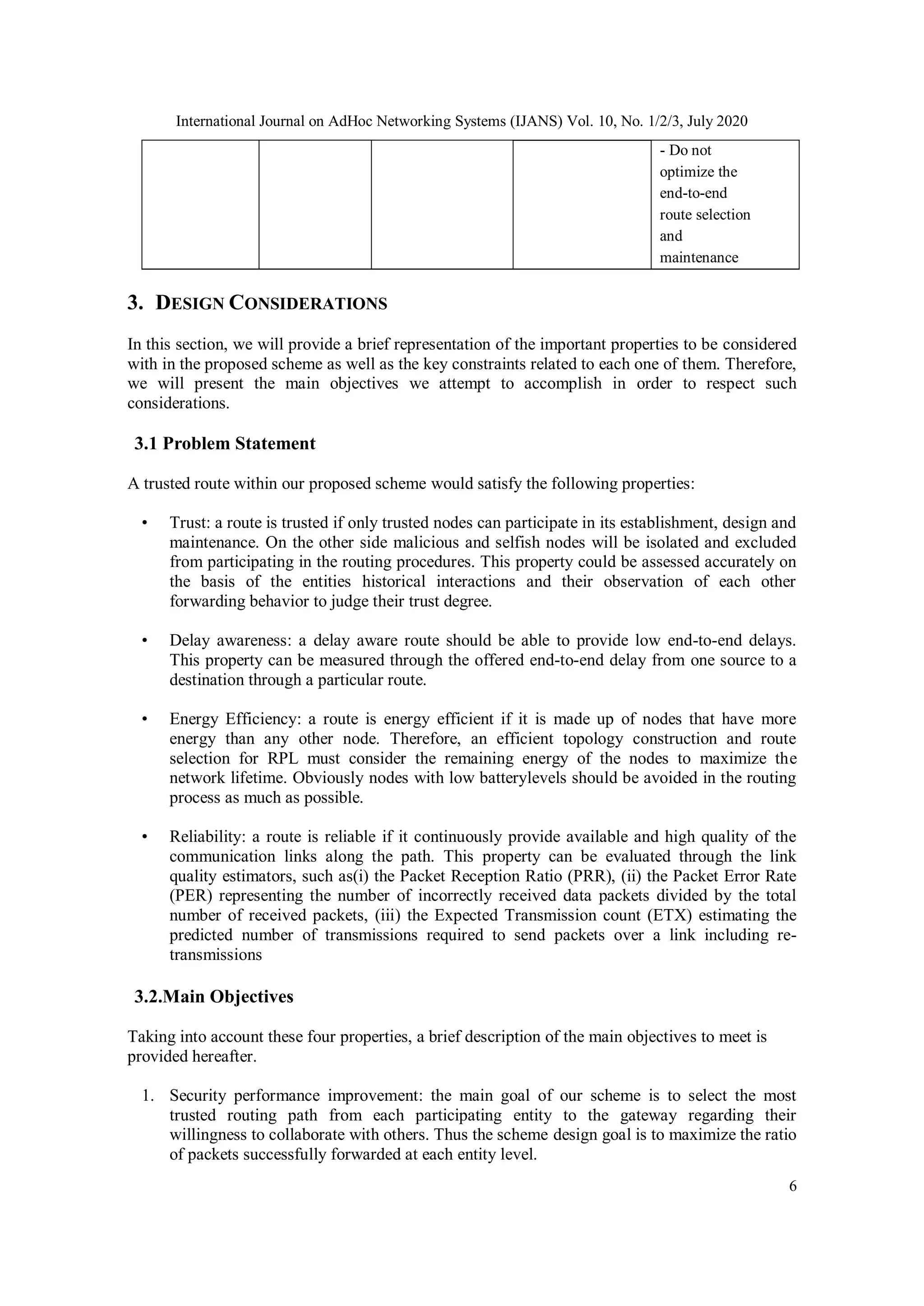

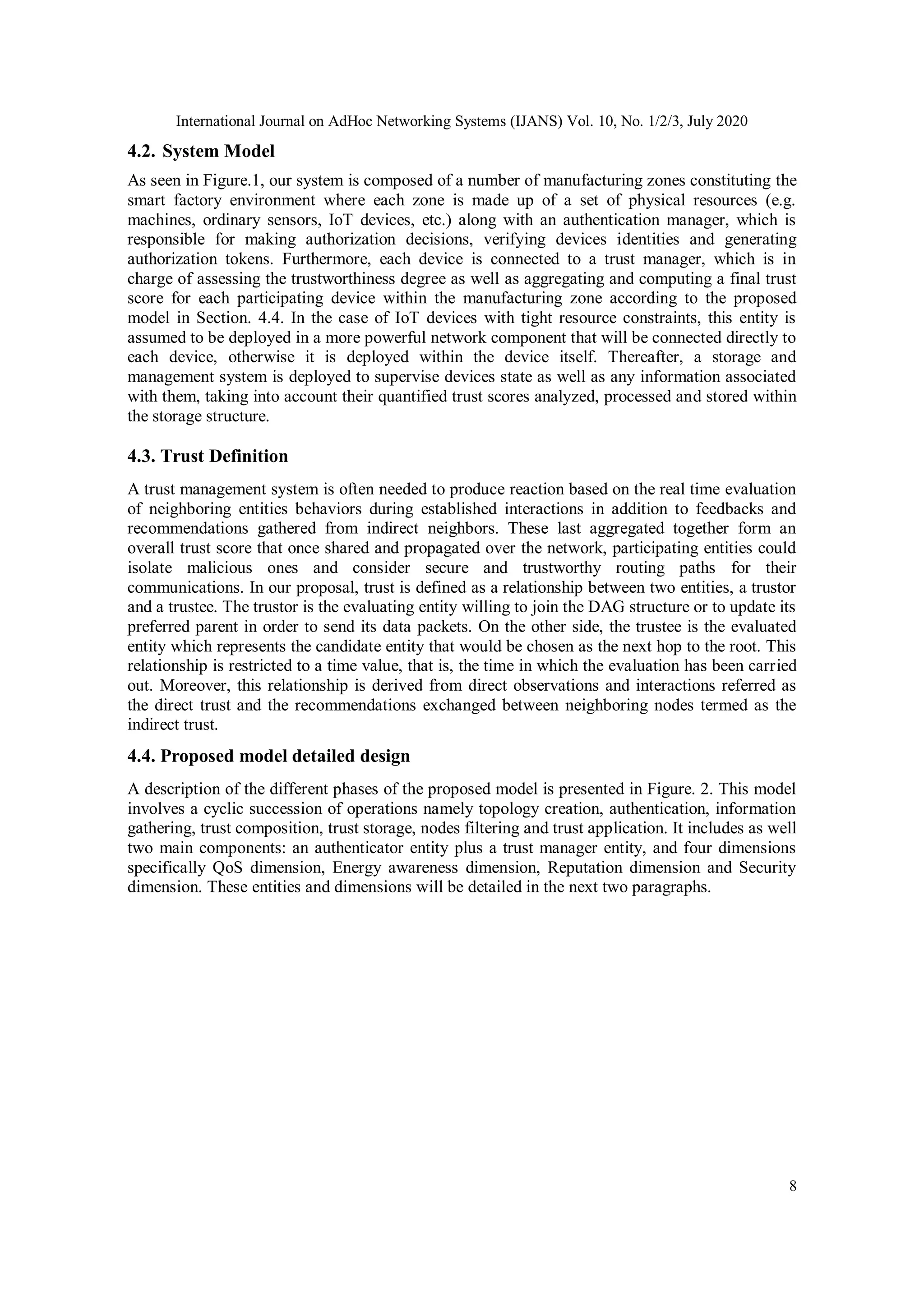
![International Journal on AdHoc Networking Systems (IJANS) Vol. 10, No. 1/2/3, July 2020
9
4.4.1. System Components
Figure 2. Architecture of the proposed model
Authenticator: This entity is mainly responsible for verifying the validity of devices’ identities
as well as the legitimacy of demands and requests sent to the trust framework. IoT devices and
smart objects are authenticated based on the provided credentials. In our framework, we rely on
the openID Connect[21] (OIDC) which is an identity layer on top of the OAuth 2.0 protocol [22].
It enables clients to verify the identity of the device based on the authentication performed
by an OpenID Provider, and to obtain basic profile information about the device in an
interoperable and REST-like manner [21]. We have chosen OIDC since it has different
characteristics related to IoT environments. OIDC is free, open and decentralized (no central
authority approves or registers relying parties or service providers). Its integration does not
require complicate update in the deployed application. Indeed, it follows a restful approach which
make it easy to use and to interoperate. Finally, it gives the possibility to use a JSON structure
token that carries information about the device. This entity could be composed of two
subcomponents:
I. The Policy Decision Component (PDC): this module is in charge of making authorization
decisions based on the policies defined to assign permissions a device has. In case of a
successful authentication process, this module generates an access token which is delivered
in order to avoid subsequent authentication procedures.
II. The Key Management Component (KMC): this module generates authentication related
keys that are used to authenticate devices’ validity within the system. Generated keys help
to guarantee a level of security of the scheme.
Trust manager: This entity helps in the isolation of malicious nodes while providing trustworthy
and secure routing paths. Consequently it enables to establish a trusted and reliable environment
where devices can interact with each other as well as with external entities and industrial IoT
services without worrying about risks related neither to devices changing behaviors nor to](https://image.slidesharecdn.com/10320ijans01-210930062715/75/Trustbased-Routing-Metric-for-RPL-Routing-Protocol-in-the-Internet-of-Things-9-2048.jpg)
![International Journal on AdHoc Networking Systems (IJANS) Vol. 10, No. 1/2/3, July 2020
10
transmitted information confidentiality and integrity. We remind here that the trust framework is
assumed to be deployed in the same target entity when it comes to non- constrained devices
whereas it could be deployed outside in case of constrained ones. Moreover, as illustrated in
Figure. 2, this last is based on five main operational phases namely information gathering, trust
composition, trust storage, nodes filtering and trust application.
i. Information gathering: Before being able to produce trust related evidence, each entity has
to gather enough information about its neighbors’ behavior as well as the links’ quality
indicators. The trust structure to be sent to the trust manager is made up of the following
information: node ID, neighbor ID, RE percentage, PFR value, ETX value, PRR value,
PER value, the transmission delay as well as the entity time.
ii. Trust composition: Upon receiving trust related information, the trust manager starts the
trust composition process consisting of computing the trust score based on Node Trust
(NT) and Link Trust(LT). This value is the weighted average of two parts as follow:
Tij(t) represents the trust score an entity ei has for ej at time t. This score is limited to a
continuous range from 0 to 1, where 0 denotes complete distrust whereas 1 represents
absolute trust.
NTij(t) represents the NT level calculated based on node cooperativeness and node
competence.
LTij(t) denotes the LT which is assessed based on link quality and link performance.
The weight factors w1 and w2 are assigned to NTij(t) and LTij(t) respectively where
w1+w2=1; 0≤w1≤1 and 0≤w2≤1.
Each computation is based on a set of properties where NTij(t) represents the NT level
calculated based on the trustor’s direct observation of its one hop neighbors’ behavior
referred as the direct
trust NTd (t) and on the other hand, on the third parties’ attributed recommendations called
the indirect or the relative trust NTrij(t)as follow:
NTij(t) = wd * NTd (t) + wr * NTrij(t) , wd and wr are the weights assigned to the direct
and the indirect trust respectively.
The direct trust is calculated by considering both node cooperativeness (coop) and node
com- petence (comp). At timet, it is defined as:
NTd (t) = NTcoop (t) * NTcomp (t), where NTcoop (t) reflects the cooperativeness level
evaluated during the time interval [0..t] and calculated using the Packet Forwarding Ratio
(PFR), while NTcompij(t) provides the degree of the entity’s ability to perform its intended
tasks within the routing process and it is assessed based on the Remaining Energy (RE)
percentage hence the energy dimension of our model.](https://image.slidesharecdn.com/10320ijans01-210930062715/75/Trustbased-Routing-Metric-for-RPL-Routing-Protocol-in-the-Internet-of-Things-10-2048.jpg)
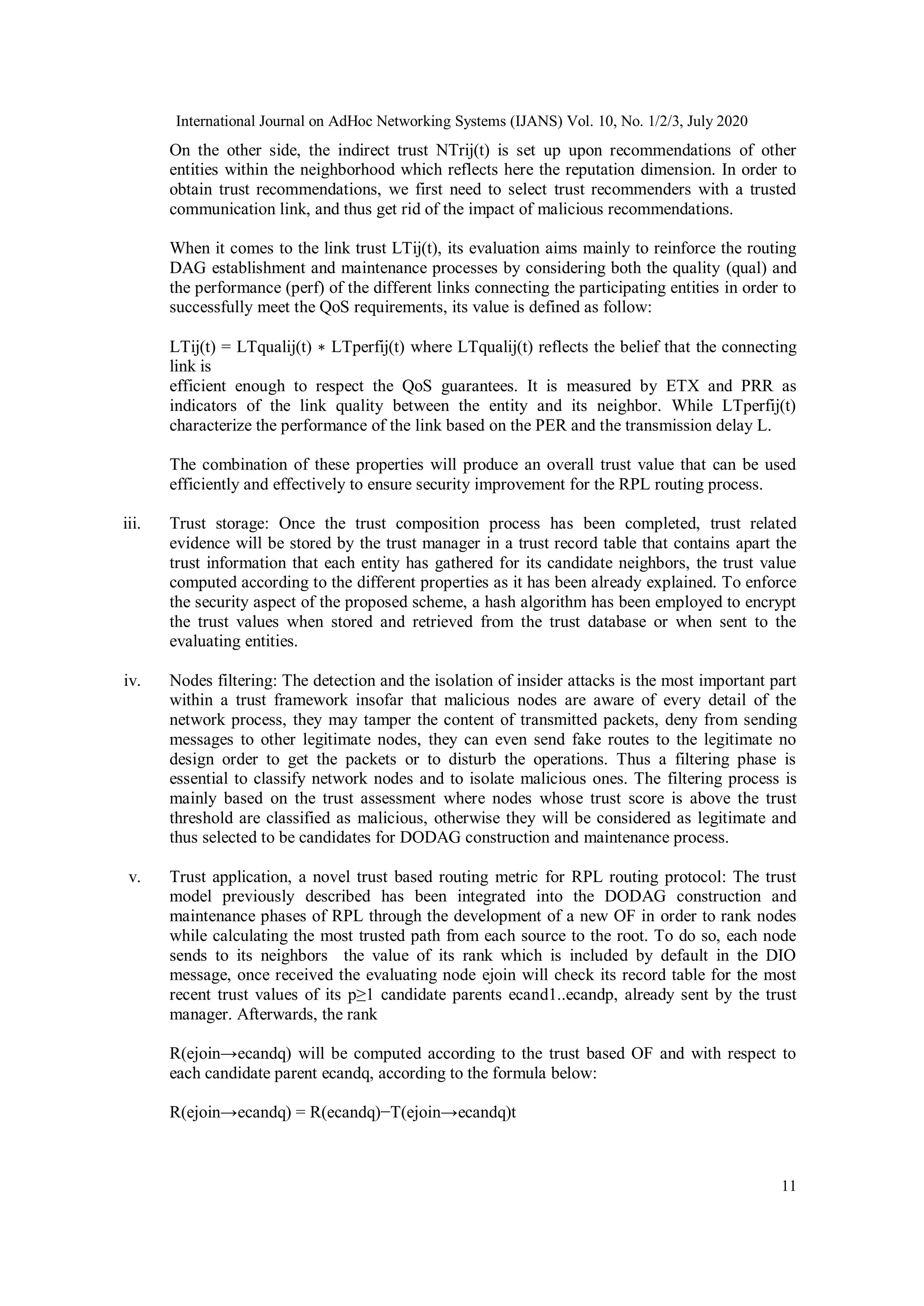
![International Journal on AdHoc Networking Systems (IJANS) Vol. 10, No. 1/2/3, July 2020
12
where R(ecandq) is the rank value of the candidate parent. Afterwards, the node with the
minimum rank R(ejoin→ecandq) will be chosen as the preferred parent to reach the root.
4.4.2. Main Dimensions
(a) QoS dimension: This dimension refers to the evaluation of the overall QoS provided by the
different links along the path. The objective here is to find a path made up of trusted nodes
connected by reliable links in terms of link quality and link performance while meeting the
end- to-end delay requirements. This evaluation is done using link indicators that include
PRR, PER and ETX.
(b) Energy awareness dimension: This dimension refers to the evaluation of the Remaining
Energy (RE) of each entity presented as a candidate parent during the construction of the
routing path. By this way, only trusted nodes that have residual energy above than a certain
specified threshold will be selected.
(c) Reputation dimension: The proposed trust model depends on the neighboring entities’
attributed recommendations about a particular entity ej regarding its packet forwarding
behavior. Let RTkj be the recommendation about ej given by ek. The trust model weights
each recommendation to limit its influence according to the recommender’s behavior and
on the other hand to the similarities between all the attributed values. Thus, each
recommendation coming from a particular entity ek is subject to a credibility factor CRk in
the interval [0..1], where 1
represents the highest credibility and 0 the lowest one. Therefore, the reputation property in
our trust model is given by Rkj=RTkj∗CRk.
(d) Security dimension: As it was presented in the network model in Section 4.1, the trust
manager after receiving the trust related information sent by the network entities, calculates
a trust score for each entity and link by means of a network monitoring and analysis tool
that captures the 6LowPAN traffic, renders the network state and identifies the abnormal
behaviors related to the RPL routing protocol. In our proposal, we have used the Foren6
analysis tool for6LowPAN/IPv6 networks.[25] The security information collected will be
employed after by the trust manager and taken into consideration within the trust
computation process.
5. SIMULATION AND RESULTS
5.1. Simulation Setup
Our experiments were performed using the Instant Contiki 2.7 platform while integrating the
proposed trust model (presented in Section 4) into the RPL routing protocol. As we have noted,
the Instant Contiki was used as the development environment with the Cooja simulator to
implement the proposed model. Let us remind that Cooja provides real environment to build IoT
networks with different types of motes, and implemented code could be tested and uploaded to
real motes without any modification. The various simulation parameters are listed in Table 2. In
this study, we have assumed that the attacking nodes behave as good nodes from inception and
begin their malicious activities during time (when activated).](https://image.slidesharecdn.com/10320ijans01-210930062715/75/Trustbased-Routing-Metric-for-RPL-Routing-Protocol-in-the-Internet-of-Things-12-2048.jpg)
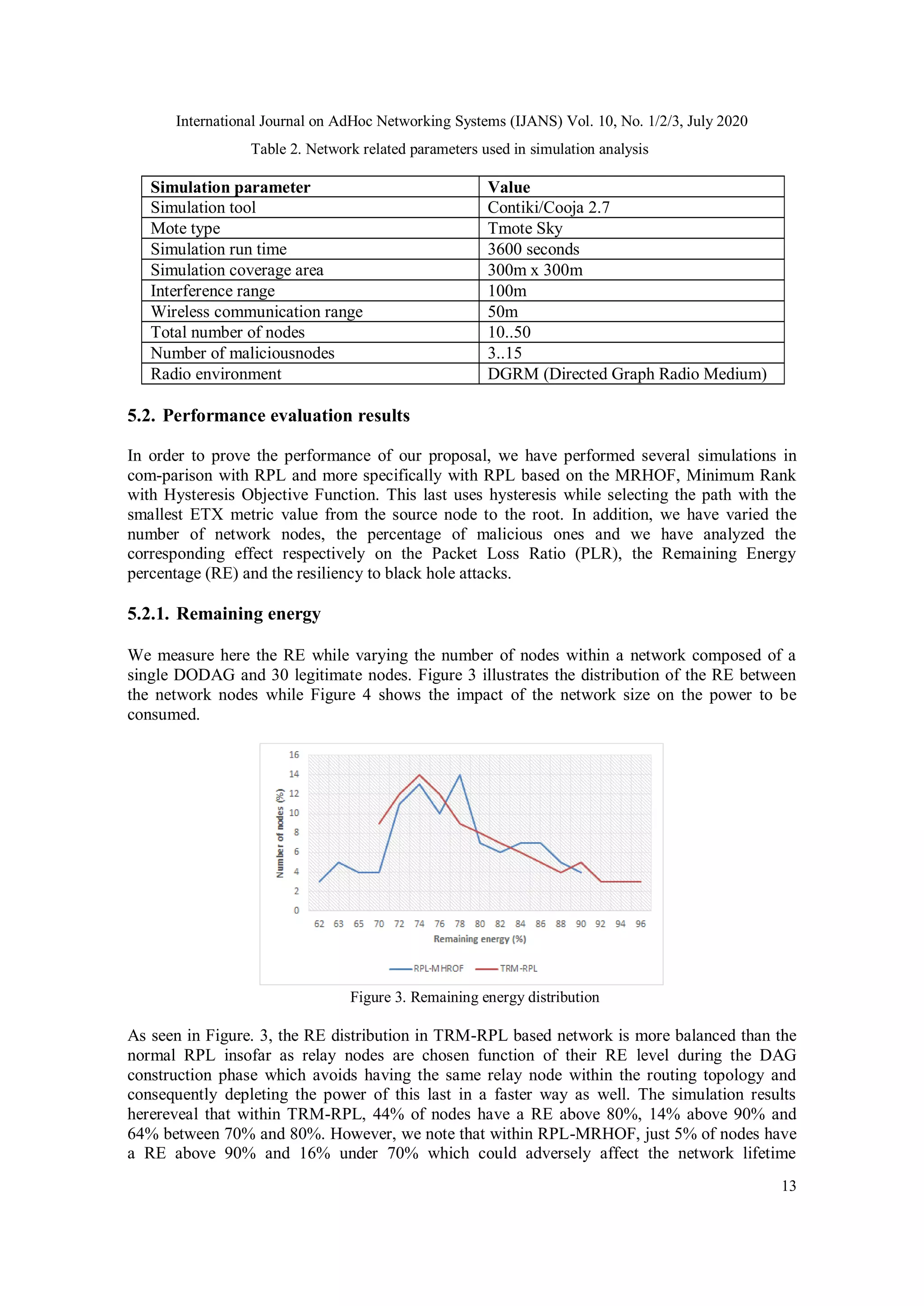
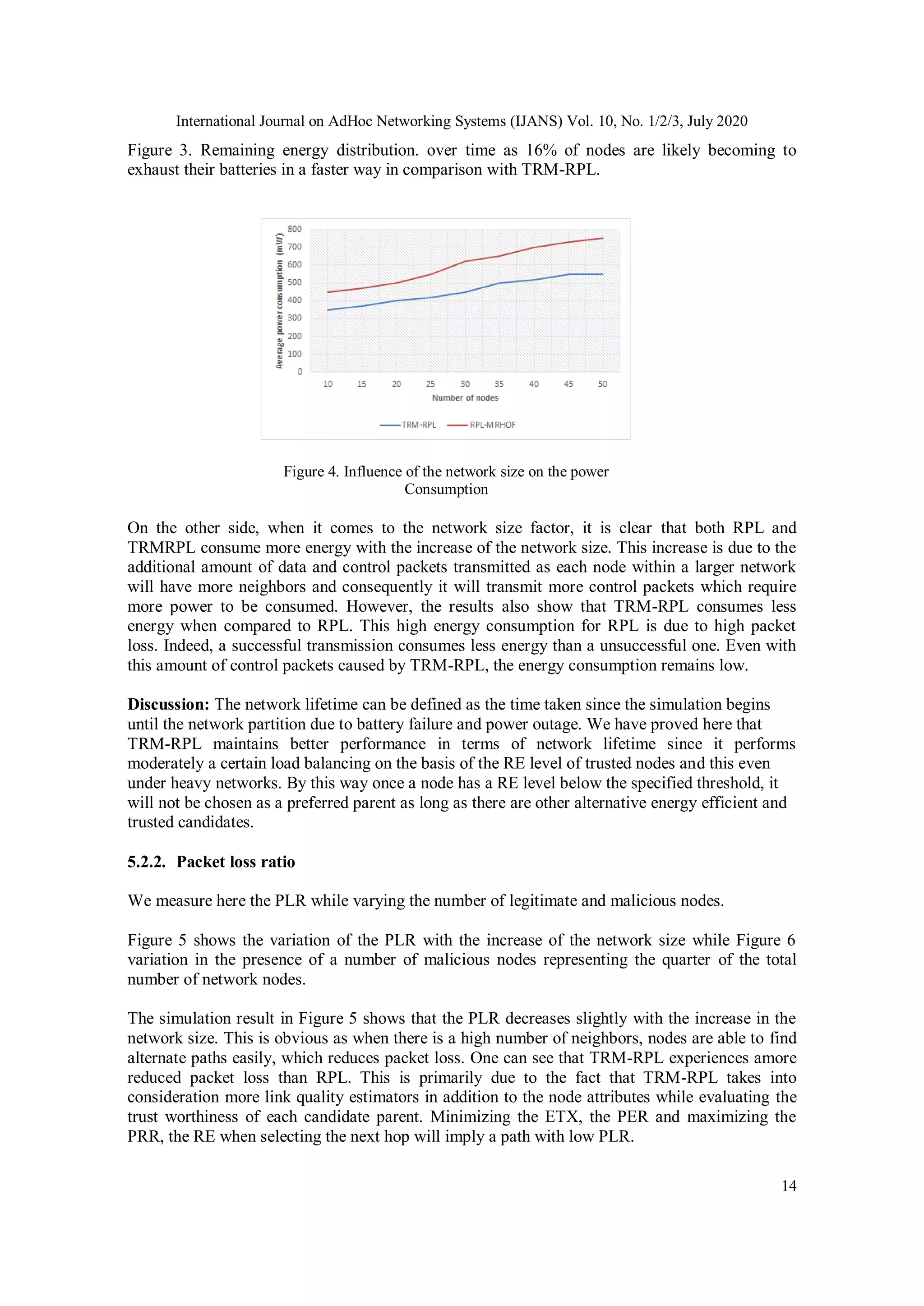
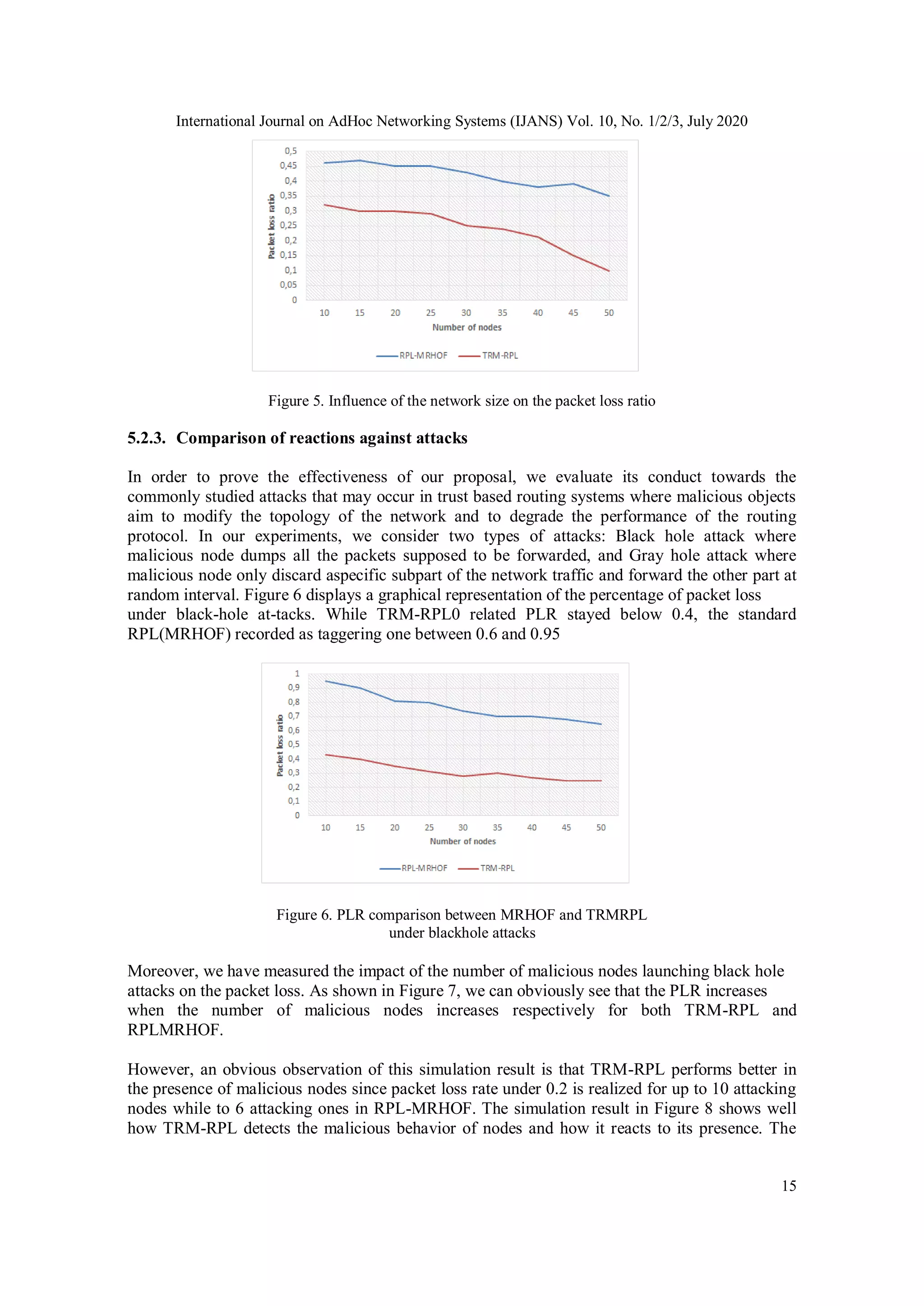
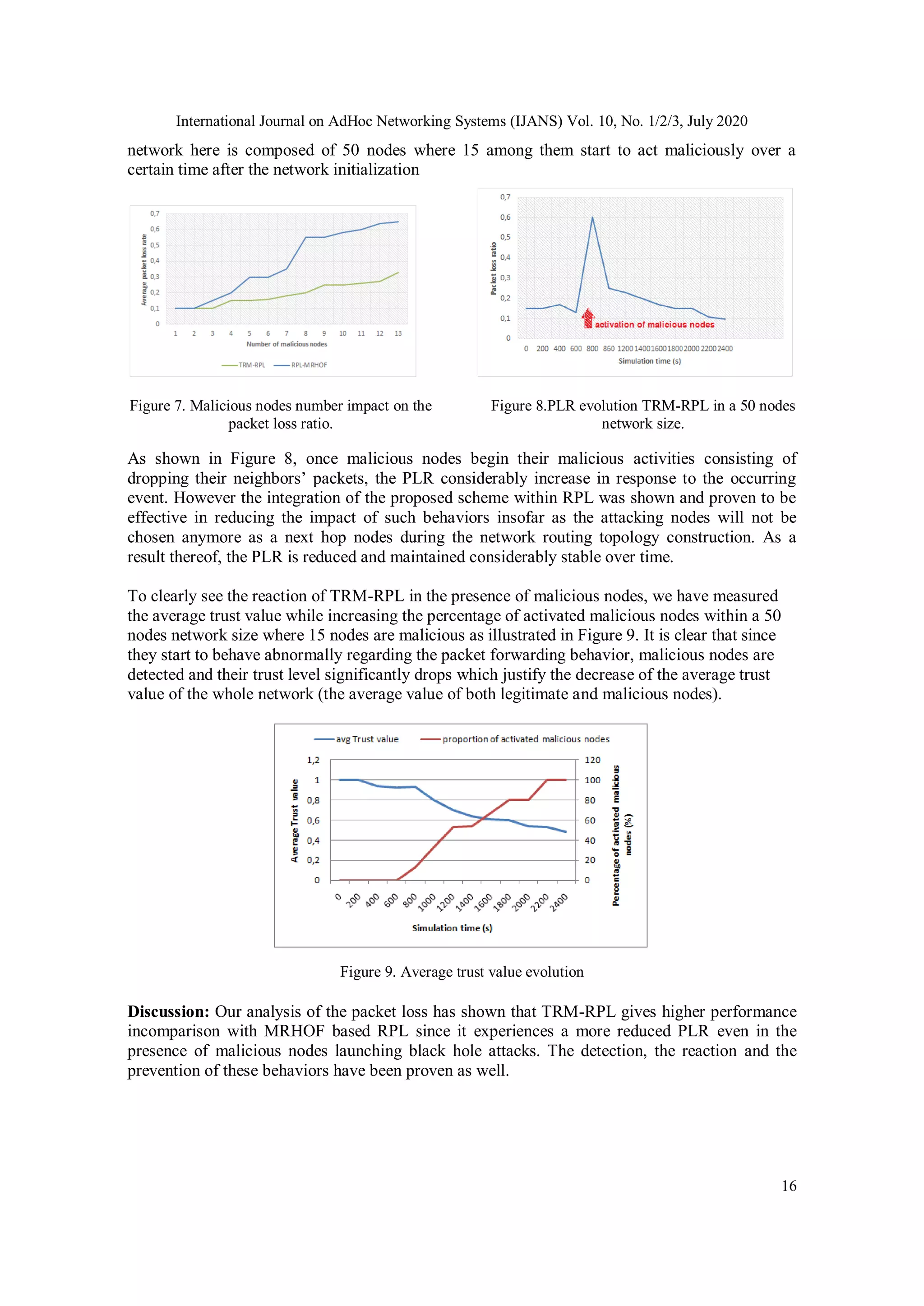
![International Journal on AdHoc Networking Systems (IJANS) Vol. 10, No. 1/2/3, July 2020
17
REFERENCES
[1] R. C. Schlaepfer and M. Koch. Industry 4.0 Challenges and solutions for the digital transformation
and use of exponential technologies. [Online]. Available:
https://www2.deloitte.com/content/dam/Deloitte/ch/Documents /manufacturing/ch-enmanufacturing-
industry-4-0-24102014.pdf
[2] K. Schwab. The Fourth Industrial Revolution. World Economic Forum, 2016.
[3] H. Kagermann and W. Wahlster, Industrie 4.0 - Smart Manufacturing for the Future. German Trade
and Investment, July 2014. [Online]. Available:
https://www.gtai.de/GTAI/Content/EN/Invest/_SharedDocs
/Downloads/GTAI/Brochures/Industries/industrie4.0-smart-manufacturing-for-the-future-en.pdf
[4] Miorandi, D., Sicari, S., De Pellegrini, F., & Chlamtac, I. (2012). Internet of things: Vision,
applications andresearch challenges. Ad Hoc Networks, 10(7), 1497-1516.
[5] Al-Fuqaha, A., Guizani, M., Mohammadi, M., Aledhari, M., & Ayyash, M. (2015). Internet of things:
A survey onenabling technologies, protocols, and applications. IEEE Communications Surveys &
Tutorials, 17(4), 2347-2376.
[6] Kushalnagar, N., Montenegro, G., & Schumacher, C. (2007). IPv6 over Low-Power Wireless
Personal AreaNetworks (6LoWPANs): Overview, assumptions, problem statement, and goals.
Internet Eng. Task Force (IETF),Fremont, CA, USA, RFC4919, vol. 10.
[7] Routing Over Low Power and Lossy Networks (ROLL), 2004. Available:
https://datatracker.ietf.org/wg/roll/charter/.
[8] Iova, O., Theoleyre, F., Noel, T. (2015). Using multiparent routing in RPL to increase the stability
and thelifetime of the network. Ad Hoc Networks 29(0), 45-62.
[9] Seeber, S., Sehgal, A., Stelte, B., Rodosek, G. D., & Schonwalder, J. (2013, October). Towards a trust
computingarchitecture for RPL in CPSs. In Network and Service Management (CNSM), 2013 9th
International Conferenceon (pp. 134-137). IEEE.
[10] Djedjig, N., Tandjaoui, D., & Medjek, F. (2015, July). trust-based RPL for the Internet of Things. In
Computersand Communication (ISCC), 2015 IEEE Symposium on (pp. 962-967). IEEE.
[11] Djedjig, N., Tandjaoui, D., Medjek, F., & Romdhani, I. (2017, April). New trust metric for the rpl
routing protocol.In Information and Communication Systems (ICICS), 2017 8th International
Conference on (pp. 328-335). IEEE.
[12] Airehrour, D., Jairo, G., & Sayan, K.R. (2016). A Lightweight trust Design for IoT Routing.
Dependable, Autonomic and Secure Computing, 14th Intl Conf on Pervasive Intelligence and
Computing,2nd Intl Conf on Big Data Intelligence and Computing and Cyber Science and
Technology Congress(DASC/PiCom/DataCom/CyberSciTech), 2016 IEEE 14th Intl C. IEEE.
[13] Khan, Z. A., Ullrich, J., Voyiatzis, A. G., & Herrmann, P. (2017, August). A trust-based Resilient
RoutingMechanism for the Internet of Things. In Proceedings of the 12th International Conference on
Availability, Reliability and Security (p. 27). ACM.
[14] Lahbib, A., Toumi, K., Elleuch, S., Laouiti, A., & Martin, S. (2017, October). Link reliable and trust
awareRPL routing protocol for Internet of Things. In Network Computing and Applications (NCA),
2017 IEEE 16thInternational Symposium on (pp. 1-5). IEEE.
[15] Duan, J., Yang, D., Zhu, H., Zhang, S., & Zhao, J. (2014). TSRF: A trust-aware secure routing
framework inwireless sensor networks. International Journal of Distributed Sensor Networks, 2014.
[16] Zhan, G., Shi, W., & Deng, J. (2012). Design and implementation of TARF: A trust-aware routing
framework forWSNs. IEEE Transactions on dependable and secure computing, 9(2), 184-197.
[17] Ahmed, A., Bakar, K. A., Channa, M. I., Haseeb, K., & Khan, A. W. (2015). TERP: A trust and
Energy AwareRouting Protocol for Wireless Sensor Network. IEEE Sensors Journal, 15(12), 6962-
6972.
[18] Winter, T. (2012). RPL: IPv6 routing protocol for low-power and lossy networks.
[19] Tripathi, J., de Oliveira, J. C., & Vasseur, J. P. (2010). A performance evaluation study of rpl:
Routing protocolfor low power and lossy networks. Information Sciences and Systems (CISS) 44th
Annual Conference on (pp. 1-6).IEEE.
[20] Accettura, N., Grieco, L. A., Boggia, G., & Camarda, P. (2011). Performance analysis of the RPL
routing protocol.In Mechatronics (ICM) IEEE International Conference on (pp. 767-772). IEEE.
[21] Gaddour, O., Koubaa, A., & Abid, M. (2015). Quality-of-service aware routing for static and mobile
IPv6-basedlow-power and lossy sensor networks using RPL. Ad Hoc Networks, 33, 233-256.
[21] N. S. et al., Openid connect core 1.0, OpenID Foundation, Tech. Rep., February 2014
[22] Hardt, Dick. The OAuth 2.0 authorization framework. (2012)](https://image.slidesharecdn.com/10320ijans01-210930062715/75/Trustbased-Routing-Metric-for-RPL-Routing-Protocol-in-the-Internet-of-Things-17-2048.jpg)